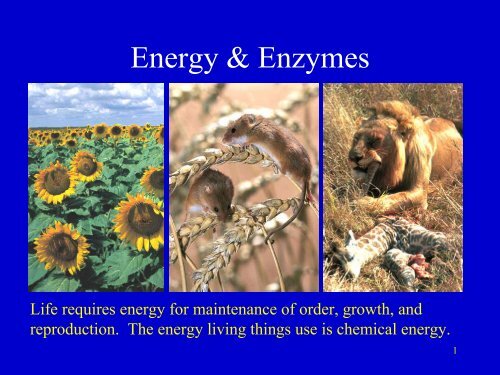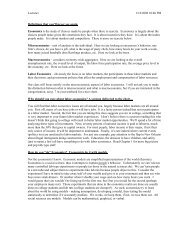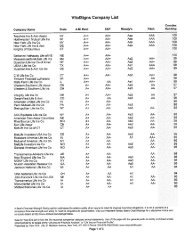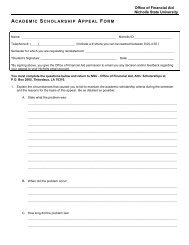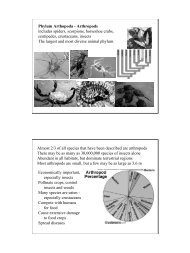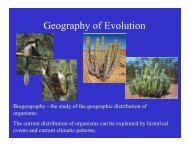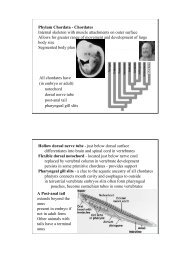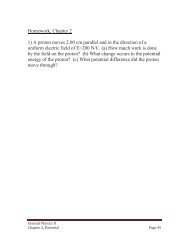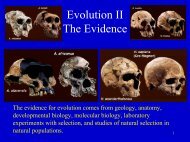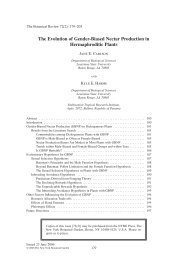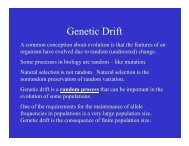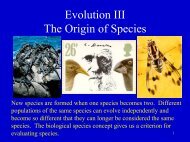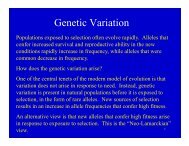Energy & Enzymes - Nicholls State University
Energy & Enzymes - Nicholls State University
Energy & Enzymes - Nicholls State University
You also want an ePaper? Increase the reach of your titles
YUMPU automatically turns print PDFs into web optimized ePapers that Google loves.
<strong>Energy</strong> & <strong>Enzymes</strong><br />
Life requires energy for maintenance of order, growth, and<br />
reproduction. The energy living things use is chemical energy.<br />
1
<strong>Energy</strong> exists in two forms - potential and kinetic.<br />
Potential energy is stored energy. Kinetic energy is the energy<br />
of motion.<br />
rechargeable battery<br />
gasoline<br />
foods<br />
electric fan<br />
a moving vehicle<br />
body heat<br />
Potential energy can be released as kinetic energy.<br />
2
Potential energy can be converted from one form to another.<br />
• Light electron position energy chemical bonds<br />
• carbohydrate chemical energy fat chemical energy<br />
• gasoline chemical energy battery chemical energy<br />
• All conversions of potential energy are inefficient<br />
• Gasoline energy can be converted to stored chemical energy of<br />
a battery, but there is heat released in the process. Heat is<br />
kinetic energy and is a loss of potential energy.<br />
• Conversion of foodstuffs also result in a loss of energy in the<br />
form of heat.<br />
• The use of foodstuffs to power muscular movements also results<br />
in the production of heat.<br />
3
Heat is molecular motion. Once chemical energy is converted to<br />
heat it is lost to living things. It can’t be recovered.<br />
4
Laws of Thermodynamics<br />
1. <strong>Energy</strong> can’t be created or destroyed, only converted from<br />
one form to another. It can be changed from one form of<br />
potential energy to another, or from potential to kinetic energy,<br />
but there is no net increase or decrease in total energy. The total<br />
amount of energy in the universe is constant.<br />
2. The net tendency of the<br />
universe is toward greater<br />
disorder (greater molecular<br />
motion). Entropy (a measure<br />
of disorder) is always<br />
increasing.<br />
It requires energy to maintain<br />
order.<br />
5
Life is ordered and maintains its order.<br />
Increasing disorder is supposed to be the rule.<br />
Does life violate the Second Law of Thermodynamics<br />
6
Oxidation-reduction (REDOX) reactions are the most important<br />
class of energy transfer reactions in living things.<br />
7
Chemical energy in living things is carried by electrons involved<br />
in covalent bonds, especially C-H bonds.<br />
<strong>Energy</strong> is<br />
transferred by<br />
moving<br />
electrons (and<br />
associated<br />
protons) from<br />
one molecule to<br />
another.<br />
NAD is an<br />
important<br />
molecule in<br />
energy transfers<br />
8
Chemical reactions involve the conversion of one class of<br />
molecules into another class of molecules. The starting<br />
molecules are called substrates or reactants. The resulting<br />
molecules are called products.<br />
Substrates<br />
Products<br />
9
In most chemical reactions the products have less total energy<br />
than the substrates. In the conversion of substrate to product<br />
some energy is lost or released. Such reactions are called<br />
exergonic reactions.<br />
G - free energy - a measure of the<br />
energy contained in chemical bonds<br />
In exergonic reactions there is a loss of<br />
free energy in the conversion from<br />
substrate to product.<br />
An exergonic reaction:<br />
C 6 H 12 O 6 + 6 O 2 → 6 CO 2 + 6 H 2 O<br />
All organisms can break down glucose<br />
as a source of energy for other<br />
purposes<br />
10
How much product will be produced from a reaction when it is<br />
allowed to go to equilibrium<br />
The ∆G<br />
determines the<br />
amount of<br />
product that will<br />
be produced at<br />
chemical<br />
equilibrium.<br />
11
In some chemical reactions the products have more energy than<br />
the substrates. Such reactions require the input of energy from<br />
another source and are called endergonic reactions. In<br />
endergonic reactions the change in free energy is positive.<br />
An endergonic reaction<br />
6 CO 2 + 6 H 2 O → C 6 H 12 O 6 + 6 O 2<br />
Plants perform this reaction in the<br />
synthesis of glucose, and supply the<br />
energy needed from energy captured<br />
from sunlight.<br />
All chemical reactions are reversible.<br />
6 CO 2 + 6 H 2 O ↔ C 6 H 12 O 6 + 6 O 2<br />
One direction is endergonic and the<br />
other is exergonic.<br />
12
If the tendency of the universe is to convert potential energy into<br />
kinetic energy, why don’t all energy containing molecules release<br />
their energy right now<br />
Some molecules do degrade<br />
readily but others don’t. Those<br />
that don’t are considered more<br />
stable.<br />
For stable substrates to be<br />
converted into products, they must<br />
be “activated” through the input of<br />
energy. The amount of energy that<br />
must be supplied to cause a<br />
reaction to occur is the activation<br />
energy.<br />
13
For most chemical reactions the<br />
activation energy comes from the<br />
surrounding environment.<br />
Molecular collisions provide the<br />
energy necessary to elevate a<br />
substrate to its activated state.<br />
Chemical reactions happen more<br />
quickly at higher temperatures<br />
because at higher temperatures<br />
there are more molecular<br />
collisions and more of the<br />
collisions have sufficient force to<br />
elevate the substrate to its<br />
activated state.<br />
14
The activation energy determines the rate of conversion of<br />
substrate to product. The higher the activation energy the slower<br />
the rate of production of product.<br />
15
Given the same amount of substrate, temperature, etc.:<br />
Which reaction will produce the least product at equilibrium<br />
Which reaction will produce product at the highest rate<br />
16
<strong>Enzymes</strong> - biological catalysts<br />
A catalyst increases the rate of a chemical reaction but is<br />
unchanged by the reaction. Catalysts can promote the formation<br />
of products from substrates repeatedly.<br />
<strong>Enzymes</strong> are<br />
proteins (or<br />
sometimes<br />
RNA) that<br />
associate with<br />
substrates in a<br />
way that makes<br />
the formation of<br />
product more<br />
favorable.<br />
They lower the activation energy needed to<br />
convert substrate to product so reactions proceed<br />
18<br />
quickly at normal biological temperatures.
<strong>Enzymes</strong> don’t change the ∆G of the reaction. So they don’t<br />
change the amount of product that can be produced at<br />
equilibrium.<br />
<strong>Enzymes</strong> make life possible by allowing reactions to proceed<br />
quickly enough for the organism to resist physical degradation.<br />
<strong>Enzymes</strong> are usually named for the reaction they catalyze and<br />
the suffix ASE is added to the name.<br />
DNAse - breaks down DNA<br />
DNA polymerase - synthesizes new DNA from nucleotides<br />
ATP synthase - synthesizes ATP from ADP and inorganic<br />
phosphate<br />
Pyruvate dehydrogenase - removes a hydrogen from pyruvate<br />
Phosphofructokinase - adds a phosphate group to fructose<br />
Ribulose Biphosphate Carboxylase - adds a CO 2 to Ribulose<br />
biphosphate<br />
19
<strong>Enzymes</strong> are large proteins which associate with a specific or<br />
very limited number of substrates. They are specific because<br />
they have an active site that matches the shape of the substrate.<br />
The substrate<br />
and enzyme<br />
have a lock and<br />
key like<br />
relationship.<br />
The enzyme<br />
may change<br />
conformation<br />
(shape) after<br />
the substrate<br />
enters the<br />
active site.<br />
After the substrate enters the active site, the<br />
binding of the enzyme helps to promote the<br />
breakage or formation of covalent bonds.<br />
20
Many of the properties of enzymes are explained by the<br />
Enzyme-Substrate Complex Model (a hypothesis about how<br />
enzymes work).<br />
<strong>Enzymes</strong> don’t get used up - they can catalyze the same reaction<br />
through an indefinite number of cycles.<br />
21
Because there is usually a limited number of enzymes in solution<br />
relative to the number of substrate molecules, enzymes exhibit<br />
saturation. As substrate concentration increases the rate of product<br />
formation increases up to the point at which all the enzymes in<br />
solution at any given time have their active sites occupied.<br />
Increasing<br />
substrate<br />
concentration<br />
further will<br />
result in no<br />
further increase<br />
in the rate of<br />
product<br />
formation.<br />
22
<strong>Enzymes</strong> are sensitive to environmental conditions<br />
Temperature influences the strength of hydrogen bonds. If the<br />
temperature is too low the enzyme may be too rigid to bind the<br />
substrate readily.<br />
At very high<br />
temperatures the<br />
enzyme may<br />
denature and<br />
catalysis stops.<br />
There is an optimum temperature for the activity of an enzyme.<br />
The optimum temperature is usually matched to the environment<br />
in which the enzyme normally functions.<br />
23
Enzyme activity is influenced by the concentration of ions.<br />
Positively or negatively charged molecules in the environment of<br />
the enzyme can change the conformation of the enzyme and<br />
influence its ability to bind the substrate.<br />
A change in pH is a change<br />
in the concentration of H+<br />
in the environment.<br />
Changing the concentration<br />
of H+ (or any other ion) can<br />
change the shape of the<br />
enzyme.<br />
<strong>Enzymes</strong> are usually well suited for the environment in which<br />
they normally work. Pepsin is a protease in the stomach.<br />
Trypsin is a protease in the small intestine.<br />
24
Enzyme activity is also influenced by other chemicals in the<br />
environment. Enzyme inhibitors reduce enzyme activity.<br />
Enzyme activators increase enzyme activity.<br />
Inhibitors are of<br />
two types -<br />
competitive and<br />
noncompetitive<br />
Noncompetitive<br />
inhibitors<br />
interact with the<br />
enzyme away<br />
from the active<br />
site - at the<br />
allosteric site<br />
25
The effect of a competitive inhibitor can be reduced through an<br />
increase in substrate concentration. The effect of a<br />
noncompetitive inhibitor is insensitive to change in substrate<br />
concentration.<br />
At higher substrate<br />
concentrations a<br />
competitive inhibitor<br />
has less access to the<br />
active site.<br />
At all substrate<br />
concentrations, a<br />
noncompetitive<br />
inhibitor remains<br />
bound to the<br />
allosteric site.<br />
26
Activators increase an enzyme’s ability to catalyze a reaction.<br />
Activators bind to an allosteric site and change the shape of the<br />
enzyme so that it is a more effective catalyst.<br />
27
<strong>Enzymes</strong> often depend on the presence of other molecules to<br />
catalyze a reaction.<br />
Cofactors are inorganic ions (Zn + , Mg ++ , Ca ++ ) that associate<br />
with the enzyme and increase the enzyme’s catalytic ability.<br />
Coenzymes are non-protein<br />
organic molecules that carry<br />
substrates to the enzyme or<br />
carry products away from the<br />
enzyme. Many vitamins or<br />
derivatives of vitamins function<br />
as coenzymes.<br />
NAD is an important coenzyme.<br />
It carries high energy electrons<br />
to and from oxidation-reduction<br />
reactions.<br />
28
Many important compounds are built or broken down in a series<br />
of reactions - a biochemical pathway.<br />
Substrate<br />
The product of one enzyme is<br />
the substrate for the next<br />
enzyme in the pathway.<br />
29
The entire of sequence of reactions in a biochemical pathway is<br />
commonly regulated through the regulation of a single enzyme<br />
early in the pathway. The end-product of the pathway is often an<br />
allosteric inhibitor (regulator) of an early enzyme. This type of<br />
regulation is called feedback inhibition or end-product inhibition.<br />
30


